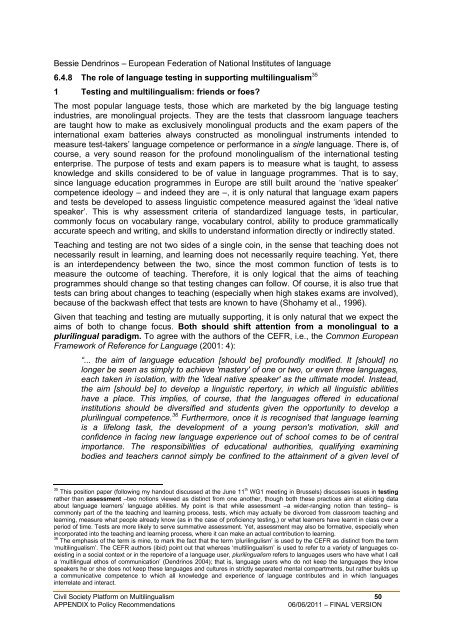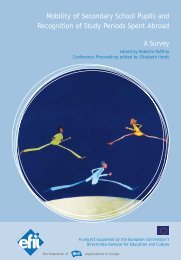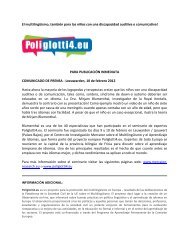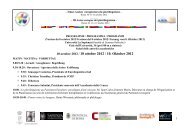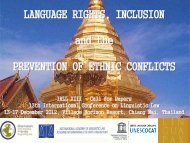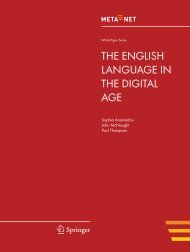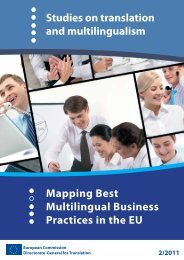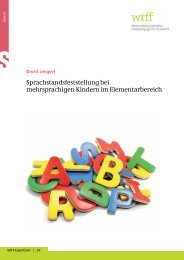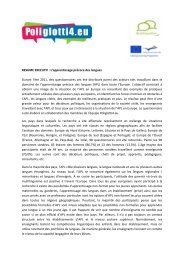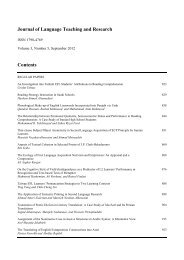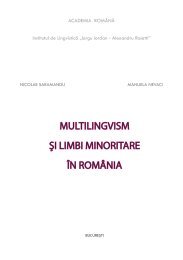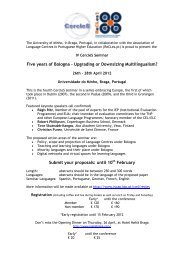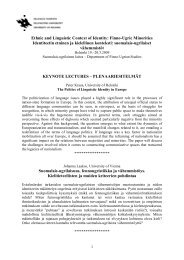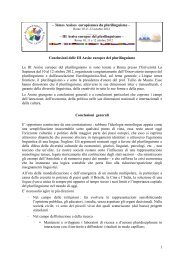FULL VERSION - European Commission - Europa
FULL VERSION - European Commission - Europa
FULL VERSION - European Commission - Europa
You also want an ePaper? Increase the reach of your titles
YUMPU automatically turns print PDFs into web optimized ePapers that Google loves.
Bessie Dendrinos – <strong>European</strong> Federation of National Institutes of language6.4.8 The role of language testing in supporting multilingualism 351 Testing and multilingualism: friends or foes?The most popular language tests, those which are marketed by the big language testingindustries, are monolingual projects. They are the tests that classroom language teachersare taught how to make as exclusively monolingual products and the exam papers of theinternational exam batteries always constructed as monolingual instruments intended tomeasure test-takers’ language competence or performance in a single language. There is, ofcourse, a very sound reason for the profound monolingualism of the international testingenterprise. The purpose of tests and exam papers is to measure what is taught, to assessknowledge and skills considered to be of value in language programmes. That is to say,since language education programmes in Europe are still built around the ‘native speaker’competence ideology – and indeed they are –, it is only natural that language exam papersand tests be developed to assess linguistic competence measured against the ‘ideal nativespeaker’. This is why assessment criteria of standardized language tests, in particular,commonly focus on vocabulary range, vocabulary control, ability to produce grammaticallyaccurate speech and writing, and skills to understand information directly or indirectly stated.Teaching and testing are not two sides of a single coin, in the sense that teaching does notnecessarily result in learning, and learning does not necessarily require teaching. Yet, thereis an interdependency between the two, since the most common function of tests is tomeasure the outcome of teaching. Therefore, it is only logical that the aims of teachingprogrammes should change so that testing changes can follow. Of course, it is also true thattests can bring about changes to teaching (especially when high stakes exams are involved),because of the backwash effect that tests are known to have (Shohamy et al., 1996).Given that teaching and testing are mutually supporting, it is only natural that we expect theaims of both to change focus. Both should shift attention from a monolingual to aplurilingual paradigm. To agree with the authors of the CEFR, i.e., the Common <strong>European</strong>Framework of Reference for Language (2001: 4):“... the aim of language education [should be] profoundly modified. It [should] nolonger be seen as simply to achieve 'mastery' of one or two, or even three languages,each taken in isolation, with the 'ideal native speaker' as the ultimate model. Instead,the aim [should be] to develop a linguistic repertory, in which all linguistic abilitieshave a place. This implies, of course, that the languages offered in educationalinstitutions should be diversified and students given the opportunity to develop aplurilingual competence. 36 Furthermore, once it is recognised that language learningis a lifelong task, the development of a young person's motivation, skill andconfidence in facing new language experience out of school comes to be of centralimportance. The responsibilities of educational authorities, qualifying examiningbodies and teachers cannot simply be confined to the attainment of a given level of35This position paper (following my handout discussed at the June 11 th WG1 meeting in Brussels) discusses issues in testingrather than assessment –two notions viewed as distinct from one another, though both these practices aim at eliciting dataabout language learners’ language abilities. My point is that while assessment –a wider-ranging notion than testing– iscommonly part of the the teaching and learning process, tests, which may actually be divorced from classroom teaching andlearning, measure what people already know (as in the case of proficiency testing,) or what learners have learnt in class over aperiod of time. Tests are more likely to serve summative assessment. Yet, assessment may also be formative, especially whenincorporated into the teaching and learning process, where it can make an actual contribution to learning.36The emphasis of the term is mine, to mark the fact that the term ‘plurilingulism’ is used by the CEFR as distinct from the term‘multilingualism’. The CEFR authors (ibid) point out that whereas ‘multilingualism’ is used to refer to a variety of languages coexistingin a social context or in the repertoire of a language user, plurilingualism refers to languages users who have what I calla ‘multilingual ethos of communication’ (Dendrinos 2004); that is, language users who do not keep the languages they knowspeakers he or she does not keep these languages and cultures in strictly separated mental compartments, but rather builds upa communicative competence to which all knowledge and experience of language contributes and in which languagesinterrelate and interact.Civil Society Platform on Multilingualism 50APPENDIX to Policy Recommendations06/06/2011 – FINAL <strong>VERSION</strong>


